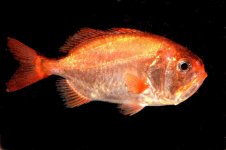All,
Here is a shot of a deepwater Japanese roughy, Gephyberyx japonicus. I got two back in April, both had bouyancy problems at first (they come from 200 to 400 meters). They would not feed, so I began tube feeding them twice a week. Eventually, to save time, I began force-feeding them whole smelt. I tried EVERY trick I could think of to get them feeding on their own. Changed environmental parameters, live foods, various stick feeding attempts, etc. Sometimes they would acknowledge the food, but would never go for it. A couple of weeks ago I tried live gambusia on a stick (one more time) the idea was that after this attempt, I was going to euthanize them. Well - one struck at a gambusia and ate it. Then it ate 7 more. The second fish started to get curious and then it began stick feeding the next day. They aren't out of the woods yet (long-term starvation can cause liver problems with fish) but it is by far the longest time I've had a fish (other than a moray) refuse to feed and then start feeding on its own.....
Jay Hemdal
Here is a shot of a deepwater Japanese roughy, Gephyberyx japonicus. I got two back in April, both had bouyancy problems at first (they come from 200 to 400 meters). They would not feed, so I began tube feeding them twice a week. Eventually, to save time, I began force-feeding them whole smelt. I tried EVERY trick I could think of to get them feeding on their own. Changed environmental parameters, live foods, various stick feeding attempts, etc. Sometimes they would acknowledge the food, but would never go for it. A couple of weeks ago I tried live gambusia on a stick (one more time) the idea was that after this attempt, I was going to euthanize them. Well - one struck at a gambusia and ate it. Then it ate 7 more. The second fish started to get curious and then it began stick feeding the next day. They aren't out of the woods yet (long-term starvation can cause liver problems with fish) but it is by far the longest time I've had a fish (other than a moray) refuse to feed and then start feeding on its own.....
Jay Hemdal






